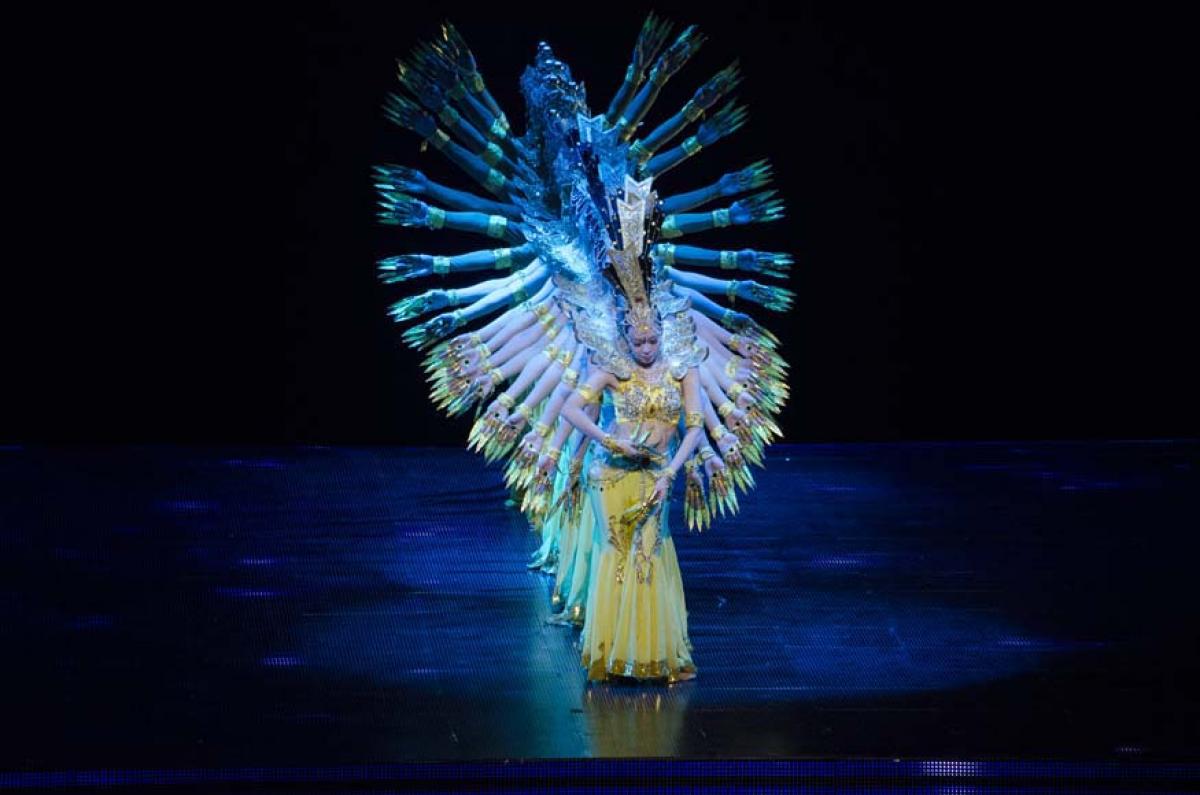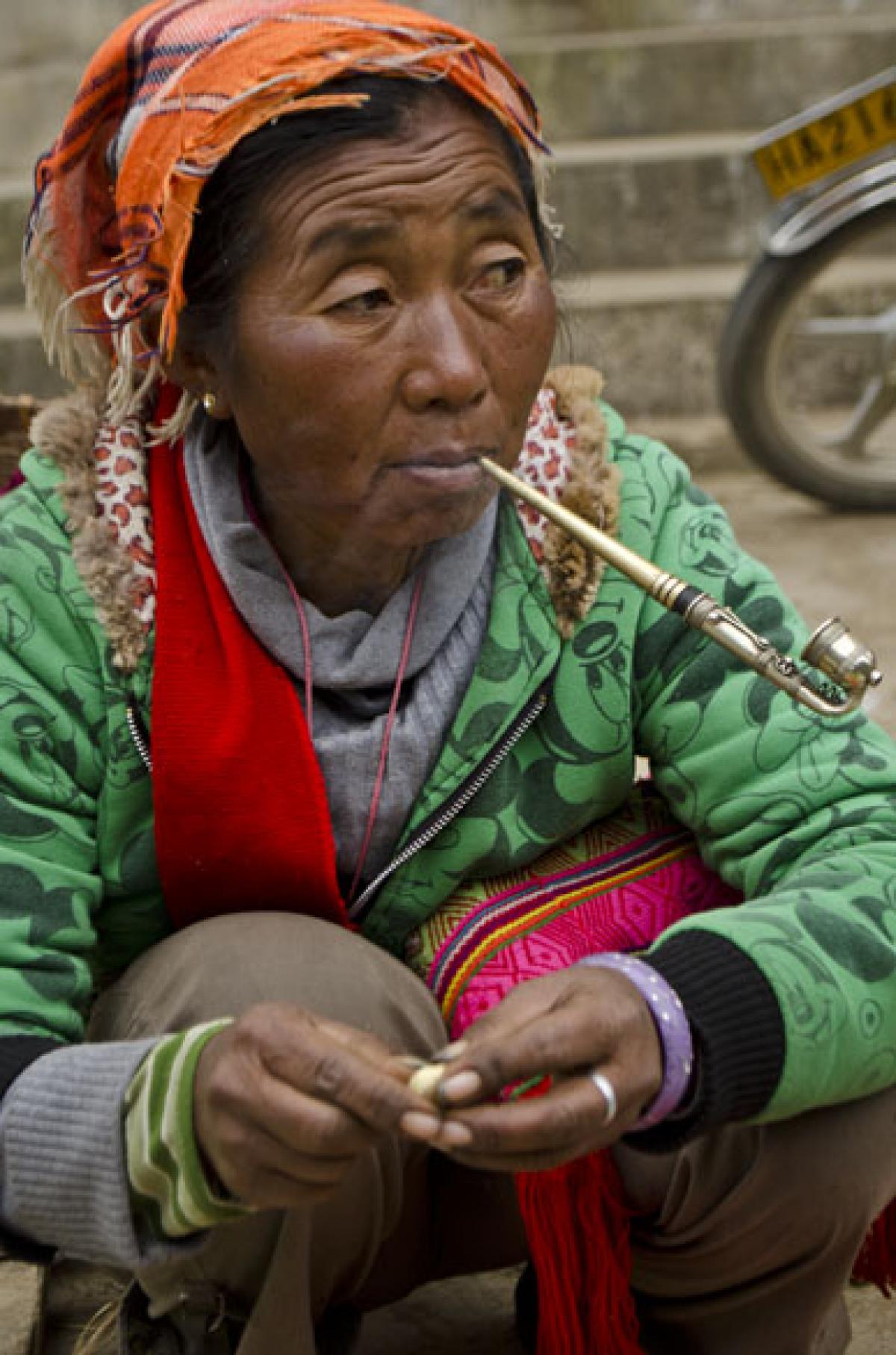Local Life in the Rural Town of Benlao
Published in People
BenLao is a small border town in China sharing a border with Myanmar. It's a small remote village about 2 hours drive from Cangyuan. The town is on the border so much that I can see the mountains of Myanmar, as a local pointed out at the first dinner I enjoyed there. I take the mornings to eat breakfast, explore the weekly market, or do laundry in the hotel. One morning, I woke up and went to the local buddhist temple for a young boys initiation ceremony. They used local paper crafts and umbrellas were hanging from the ceiling to decorate the temple. One day, I went to the white stupa, which was really resplendent and beautiful with big white towers reaching into the clear blue sky. The temple resembled Myanmar temple construction with long spires and buddhas inside.
Who is Selling at the Cangyuan Market?
Published in China
A few days after the New Year, it was an auspicious sign symbolizing new beginnings to see the the slightest crescent moon out during the night drive from the airport in Lincang to Cangyuan Wa Autonomous Region. The Wa minority are the major ethnic group of the region, whose culture is defined by colorful hand weaved clothes, dance and traditional storytelling. They don't have a written language unique to the area like Burmese, but they use english letters to form words. There were American missionaries that arrived over 100 years ago and then left, and there are Catholic churches here in the city. From what I'm told, Wa culture primarily resides in Myanmar with a population of over 600,000, and in China the numbers are much smaller with around 400,000 people. Cangyuan is the biggest city in the county. In a few of the shops the people I met were from Myanmar, but their Chinese was so perfect I would have guessed they were Chinese. Although the further out of this main city I went, the more Myanmarese immigrants I encountered who did not speak Chinese, and only spoke Wa and maybe Burmese as well.
The winding 4 hour drive from Lincang eventually led me to the Nangunhe hotel in a fairly well developed town obviously in transition to a city. The construction here is part of the national development for the entire country, so the new airport and corresponding shopping malls and hotel complexes all concerted together are radically transforming this off the map town into a modern city. We drive past rows and rows of shops, some selling fancy clothes, household items, and other wares, English pubs or café's, and of course Chinese food restuarants. I notice wooden housing on stilts simply thrown together amidst the major construction, with narrow brick streets leading into the suburbs with gated houses. It's common to see the Wa or Dai minority villagers here amidst the crowds sitting on the side of the street with their produce or otherwise handmade goods which they brought from the rural areas. In the morning, I eat a normal Chinese breakfast of mushroom baozi, which are bread rolls with a savory mushroom filling, and rice porridge. Then I take a walk around and check out the shops. Some of the traditional clothing shops have black, red, and deep purple colored clothing weaved into skirts and shirts. Their clothing has their cultural symbol of the bull embroidered on the front. This symbol is also found throughout the city in sculptures of bulls together or bulls heads, adorning the outside of the county buildings, and overall ingrained in the cultural heritage of the area. A few of the people, not all, wear sandalwood paste on their faces as in Myanmar, but when I ask they are local to the area.
I eventually reach an open air vegetable market, where the local rural people bring their produces to sell in the street. The inner section of the market seems to have more established vendors inside a main market building selling traditional clothes, toys, meats, rice, shoes, and knick knak items. These stalls don't change and are the same day after day. The meat market is in the very inner core, and there's also a section for selling live animals including fishes, chickens and ducks. I also found 20 different kinds of rice being sold by one vendor, and have since walked through many rice fields and tried many of these different varieties.
The vendors outside are mostly ladies, some are Wa minority people, and some are Dai minority people. At first, I couldn't tell their was a difference, but after a few days of exploring the area it became obvious which minority they were from from their clothing. Wa people usually wear a colored head wrap, often have a long pipe, and embroidered or woven brightly colored often neon bright clothes. Dai people often wear white, grey or pink colored head wrap. They often have Buddhist clothes, and often wear lighter colors. I later found out that the Dai people constructed all of the Buddhist temples in Cangyuan, which I document in another photoset on the blog.The vegetables they weigh with a rudimentary, tarnished, often broken scale and weights. Most of the younger women don't like to get their picture taken, but luckily the older women don't mind. Since they speak Chinese I can have a conversation if they ask me questions, and once I was invited to a wedding by a complete stranger!
11 Festivals in Xinjiang Autonomous Region
Published in People
|
Corban Festival (Muslim People) |
Corban Festival also known as Eid al-Adha or feast of the sacrifice, when Muslims slaughter lambs to feed the hungry. It is an important annual traditional festival for Muslims, and is celebrated on Dec. 10th on the Islamic calendar, which is the beginning of Oct. on the western Gregorian calendar. Before Corban, People clean their houses, tidy their clothes. The first day of the festival people go to the mosques at sunrise, wearing their finest clothes, to attend the largest religious service of the year. People listen to imams or interpretations of the Koran, and the sounds of the prayers can be heard from the mosques. The festival lasts for 5 days. Each family slaughters a sheep, camels, cows or oxen and families and friends gather together to enjoy the dishes together. There is a lot of joviality, singing, and mirth surrounding this festival. Uhyghr people in Xinjiang hold large singing and dancing performances, and Kazakh, Kirgiz, Tajik, and Uzbek people hold various celebrations including horse racing and wrestling. It is a good chance for people to enjoy a family reunion, and entertain their friends.
Grape Festival (Uygur People)
The Grape Festival is a chance to celebrate the harvest season. The festival has taken place since 1990, and includes singing, dancing, Silk Road tourism exhibitions, and fnformation on China’s grape cultivation. Hundreds of varieties of grapes hang on the vines, and are ready for picking, drying, and processing. Expect plenty of cultural performances in the rural countryside. Turpan is an oasis town, covered in vine trellises, where every household has some business in grape growing, and the local markets are full of sweet dried raisins.
Eid ul-Fitr (Muslim People)
Eid ul-Fitr often called Fast Breaking Festival, is a three-day Muslim holiday that marks the end of Ramadan, the Islamic holy month of fasting. The festival lasts for three days. On the first morning, people gather together in the mosque to pray. They wear national costumes and butcher fat stocks and cook traditional snacks.
Nowruz Festival
Nowruz Festival is celebrated as the traditional New Year for Uyghurs, Kazaks, Kirgiz, and Uzbeks in China’s Xinjiang region. It is celebrated around March 21st, which is the first day of spring, and the beginning of the year on the Iranian calendar. This festival is celebrated in many countries like Iran, Afghanistan, Kurdish regions of Iraq, Turkey and central Asian countries. It marks the beginning of the planting season. There are several traditional activities that the people take part in. In one activity, the head of the family waves burning pine and fir branches over the heads of the family. There is a traditional Nowruz porridge, “Harach” that is made from many ingredients that is served at lunch. There are many different traditional performances and celebrations that include singing, dancing, wrestling, and acrobatics.
Falcon Cultural Festival
During falcon cultural festival, people ride horses and show off their hunting skills in Aki county in the Northwest of Xinjiang. The festival happens around March 21st. Krigiz herders come together to display their falcons and watch the falcons devour their prey.
Nadam Festival
Nadam festival is a folk festival of the Mongolian ethnic group. It happens during July and August and is a 10 day traditional festival, where “nadam” means amusement and entertainment” The festival is celebrated in Bayanbulak prairie in the Mongolian Autonomous Prefecture of Bayingolin, northwest China’s Xinjiang region. The festival is celebrated in the middle of July. There are many activities including lassoing competitions, “dawaz” or tightrope walking”, wrestling, horse racing, and archery. The Bayanbulak grassland is the secon largest grassland in China.
Ice and Snow Tourism Cultural Festival
Xinjiang has a wide range of winter tourism exhibits, because Xinjiang has a high quality of snow. There is great skiing. Tourists can try ancient skis made from sheep skin and wood. There has been a large development of tourism facilities in key scenic spots and ski resorts. The Altay mountain regions include the stunning Kanas Lake, where animals and plants of South Siberia can be found. There is antique ice and snow entertainment. Near Urumqi city, the capital of Xinjiang, the Tianshan mountains also include activities for the Ice and Snow Tourism Festival. Around Urumqi there are almost 30 ski resorts, which can accommodate about 20,000 people a day. There are Ice sculptures and camel trains.
Heavenly Horse Festival
The Heavenly Horse Festival is held in Ili, Xijiang, which is the Kazak Autonomous Prefecture. The festival lasts for about a month. During the festival people celebrate horse racing, horsemanship, archery, girl chasing, and Ili is an incredible landscape with heavenly mountains, grasslands, forests, lakes, valleys, ancient ruins, and other incredible sites. hiking horse adventures.
International Folk Dance Festival
Xinjiang International Folk Dance festival happens in mid-July. The festival has attracted more than 2,000 dancers from home and abroad to share their talents with the people of Xinjiang. The festival lasts 17 days and holds 80 performances by 30 professional dance groups.
Aqin Aytis festival
The Aqin Aytis festival in Fuyun county occurs at the end of September. There are many traditional arts and crafts displayed by the Kazak ethnic group. There are various traditional folk sports displayed, including camel racing. There is also a poetry storytelling contest.
Baroti Festival
Baroti Festival is also known as the Lantern Festival, which is an annual religious festival of the Islamic Tajik people. Families make special lanterns coated with butter or sheep fat and the families sit around the lantern together in the evening when it gets dark. Everyone in the family lights their own torches and says prayers. There is a large banquet to enjoy. And in the evening a celestial lantern is hung under the roof of the house. Throughout the night, people dance and sing under the torches.




